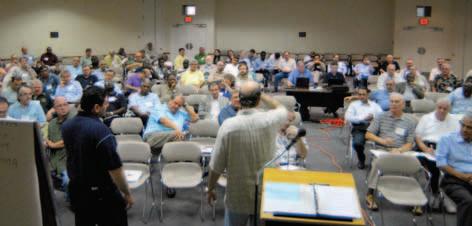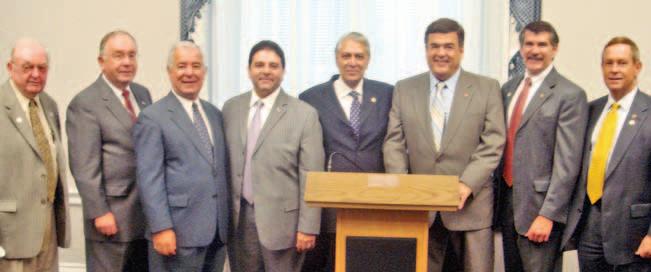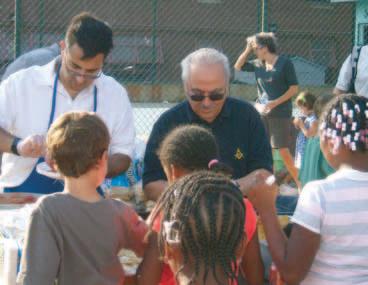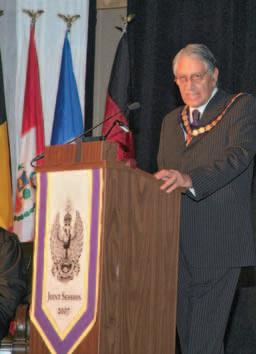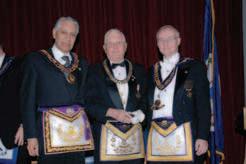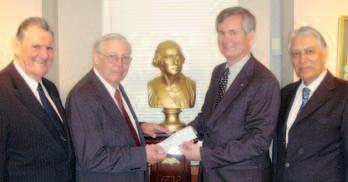
5 minute read
Grand Lodge Leadership Conference, Sept. 7-8, 2007
Grand Lodge Leadership Conference Front Royal, Virginia, Sept. 7-8, 2007
by W. Bro. Dalton S. West
Over 100 DC Freemasons gathered in beautiful Front Royal, Virginia for the 2007 Fall Leadership Conference
The Grand Lodge Leadership Conference took place in Front Royal as in past years; however, apart from a similar name it differed greatly from previous gatherings. As part of a comprehensive reorganizing of the work of the Grand Lodge, various aspects of work are now divided into two broad categories. Category one is the continuation of the training workshops initiated this past year whereby the ritual and station-by-station work of all lodges is conducted through a series of workshops occurring over two weekends in 2007 and 2008.
Category two is a specific leadership training which is now the focus of the Front Royal retreat.
Front Royal developed three broad objectives: I. Overview and challenge of leadership in the context of basic Masonic principles; II. Focused review of specific blue lodge objectives achieved through senior officer interactions and commitments; III. Training sessions on principles of leadership.
Overview and Challenge of Leadership Most Worshipful Grand Master of Masons of the District of Columbia Robert Heyat opened the conference by explaining how Masonry blends into a harmonious whole the principles of philosophy, personal beliefs, truth, good, morality, and freedom. MW Heyat stressed in particular that everyone needs to feel a relationship to something greater than oneself which is part of the core appeal of Masonry. Effective development for a Mason is a matter of exercising proper qualities of leadership. And leadership is doing what is right, based on knowledge and morality. MW Heyat cited several conditions for successful leadership but emphasized that the keys of success are knowledge that a goal is attainable and having the dedication of work ethic to achieving that goal. MW stressed that a Freemason and leader must make a difference by his actions. The Deputy Grand Master Akram Elias focused the Heyat remarks into a action plan for the forthcoming Masonic year. RWB Elias stressed that both sides of “Freemason” must be understood—”Free” and “Mason”—one referring to knowledge, the basis of freedom, and other to the practitioner, or person who struggles against the timeless enemies of ignorance and despotism. In order to achieve that mission it is necessary to enlighten the membership, energize and engage the leadership. Elias stated that American Freemasonry stands at the cusp of a unique and great opportunity today. Masonry in general and specifically in the District of Columbia could play a key role in the struggle against ignorance and despotism saying that Masons would know they had achieved their proper place in society when the Grand Master was on the short list of important invitations in the city.
Focusing – Framing the Masonic Future in Washington The first working sessions were devoted to an interactive pursuit of commonality in the aspirations and goals of the leaders present at the conference. This part centered on what individuals thought were the
goals and objectives of Freemasonry in Washington and specifically how Freemasonry was unique from other organizations. widely acclaimed and most discussion focused on how this definition could be translated into community action. The central idea of combating ignorance through education emerged early in many formats not only with regard to the public but as it applied to the DCGL Masonic membership. There was widespread agreement that the core principles and beliefs of trayed to the public Akram Elias. leading to a discus- sion of
and live by example. (One of the ways to gain recognition is to live up to our own obligations vis à vis the During considerable floor discussion brethren came Education and the Community – RWB Akram Elias up with a list of twenty-five goals and objectives took the opportunity to explain several initiatives (many of which were simply variations on the same that the Grand Lodge had undertaken with respect to themes), and then presented both goals and means education in the District of Columbia, meetings held for achieving them. The core ideas and goals called with educational authorities, and steps that had for the need of more growth; greater relevancy, visialready been taken to involve Masons in the District. bility and community participation; development of The central idea of these discussions is to focus on six new ideas stimulating the membership and celebrateducational projects (individual schools, cluster ing diversity. Possible means for achievement were schools, etc.) as determined in cooperation with the thought to be projecting a better public image; diseducational authorities. It is anticipated that by posipelling the idea of elitism; overcoming inertia; moving tioning our resources on a small number of problem outside old ways; leading by example; and changing schools a more significant impact could be achieved. the vision of Freemasons in Washington, D.C. Discussions were ongoing about further initiatives The Brethren were challenged to think about how that could be implemented. Freemasonry was different than other organizations Discussion revealed that an initial project of this sort in Washington. The core definition of Masonry as “a was launched last year among the cluster schools on fraternity brought together by brotherly love” was the Hill, led by Naval Lodge and Washington Daylight Freemasonry must be porBrother Dan Goldberg facilitates leadership training with assistance from RW Bro. community.) the values most dear to Masons: honor, ritual, tolerLodge. a project that Anacostia Lodge would join in ance, intellect, diversity, belief in a Diving Being, and the forthcoming effort. Working closely with the para sense of obligation in brotherhood. ent-teacher association it was possible to develop a high profile “Back to School Fun Fair” that succeeded Creating the Action Agenda: in raising several thousand dollars to support the Implementation became the next item of business. library in the cluster schools. This was only one Four central elements were identified including: 1) example among many of what could be achieved in Getting back to core values; 2) Creating an effective management team; 3) Reaching out to the community; 4) Creating an action agenda. It was the community by individual lodges working either independently or cooperatively. acknowledged that to overcome the public stigma of Higher Education and Freemasonry Awareness –Freemasonry and to gain (or re-gain) the confidence Higher education in Washington, D.C. offers great of the public would mean that Masons themselves opportunities to promote better relationships become knowledge- able in their craft by practicing in between universities and Freemasonry. Such exampublic their beliefs. As one member put it, Masons ples of outreach are the Square and Compass Club, must not only believe, they must do what they believe scholastic and social fraternities. Fraternity Lodge is
